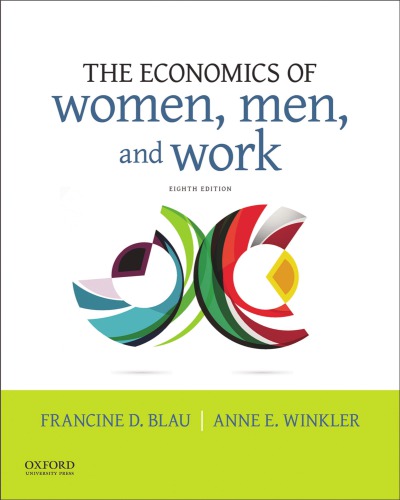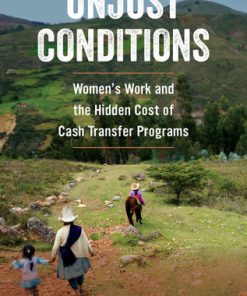The Economics of Women, Men, and Work 1st edition by Francine Blau, Anne Winkler 0197608753 9780197608753
$50.00 Original price was: $50.00.$25.00Current price is: $25.00.
The Economics of Women, Men, and Work 1st edition by Francine D. Blau, Anne E. Winkler – Ebook PDF Instant Download/DeliveryISBN: 0197608753, 9780197608753
Full download The Economics of Women, Men, and Work 1st edition after payment.

Product details:
ISBN-10 : 0197608753
ISBN-13 : 9780197608753
Author: Francine D. Blau, Anne E. Winkler
The Economics of Women, Men, and Work, Ninth Edition, is the most current and comprehensive source available for research, data, and analysis on women, gender, and economics. Blau and Winkler are widely known for their research and contributions on the study of the economics of gender. The ninth edition includes fully updated data and research, and analyzes the consequences of recent developments in the labor market for men and women. These developments include the declining gender wage gap, rising wage inequality, and the growing divide in labor market and family outcomes by educational attainment.
The Economics of Women, Men, and Work 1st table of contents:
Part I Introduction and Historical Perspectives
1 Introduction
What Economics is About
Uses of Economic Theory
The Scope of Economics
Individuals, Families, and Households
A Further Note on Terminology
Outline of the Book
Questions for Review and Discussion
Key Terms
2 Women and Men: Historical Perspectives
The Source of Gender Differences: Nature versus Nurture—The Ongoing Debate
Factors Influencing Women’s Relative Status
Women’s Roles and Economic Development
The US Experience
Colonial America: The Preindustrial Period
Period of Industrialization
The Evolution of the Family and Women’s Labor Force Participation
Historical Evidence on Occupations and Earnings
Conclusion
Questions for Review and Discussion
Suggested Readings
Key Terms
Part II The Allocation of Time Between The Household and The Labor Market
3 The Family as an Economic Unit: Theoretical Perspectives
The Simple Neoclassical Model: Specialization and Exchange
Comparative Advantage
Specialization and Exchange: Numerical Examples
Decreasing Gains to Specialization and Exchange and the Shift Away from the Traditional Family
Disadvantages of Specialization
Lack of Sharing of Housework
Life Cycle Changes
Costs of Interdependence
Tastes and Bargaining Power
Domestic Violence
Advantages of Families beyond Specialization
Economies of Scale
Public Goods
Externalities in Consumption
Gains from Shared Consumption
Marriage-Specific Investments
Risk Pooling
Institutional Advantages
Transaction Cost and Bargaining Approaches
Conclusion
Questions for Review and Discussion
Suggested Readings
Key Terms
4 The Family as an Economic Unit: Evidence
Time Spent in Nonmarket Work
Time Spent in Housework
Time Spent with Children
Time Spent in Volunteer Work
Estimating the Value of Nonmarket Production
The American Family in the Twenty-First Century
Conclusion
Questions for Review and Discussion
Internet-Based Data Exercise
Suggested Readings
Key Terms
5 The Labor Force: Definitions and Trends
The Labor Force: Some Definitions
Trends in Labor Force Participation
Broad Labor Force Trends by Gender: 1890 to Present
Labor Force Trends by Race/Ethnicity
Labor Force Trends over the Life Cycle
Trends in Labor Force Attachment of Women
Trends in Hours Worked
Trends in Gender Differences in Unemployment
Conclusion
Questions for Review and Discussion
Internet-Based Data Exercise
Suggested Readings
Key Terms
6 The Labor Supply Decision
The Labor Supply Decision
The Budget Constraint
Indifference Curves
Substitution in Consumption
Substitution in Production
Substitution Between Market Goods and Nonmarket Time
Tastes
The Labor Force Participation Decision
The Value of Nonmarket Time (w*)
The Value of Market Time (w)
The Hours Decision
Empirical Evidence on the Responsiveness of Labor Supply to Wages and Income
Economic Conditions
Some Applications of the Theory: Taxes, Childcare Costs, and Labor Supply
Taxes and the Decision to Work
Government Subsidies of Childcare and Women’s Labor Force Participation
Other Factors Affecting Childcare Costs and Women’s Labor Force Participation
Analyzing the Long-Term Growth in Women’s Labor Force Participation
Factors Influencing the Value of Market Time (w)
Rising Qualifications: Education and Experience
The Demand for Female Labor
Overall Productivity Increases
Factors Influencing the Value of Nonmarket Time (w*)
Availability of Market Substitutes and Household Appliances and the Role of Technological Change
Demographic Trends
Changing Role of Husband’s Income
Tastes
Recent Trends in Women’s Labor Force Participation: Has the Engine of Growth Stalled?
Analyzing Trends in Men’s Labor Force Participation
Black and White Participation Differentials: Serious Employment Problems for Black Men
Conclusion
Questions for Review and Discussion
Suggested Readings
Key Terms
Part III Labor Market Outcomes: Theory, Evidence, and Policy
7 Evidence on Gender Differences in Labor Market Outcomes
Gender Differences in Occupations
Overview of Gender Differences in Occupations
Measuring Occupational Segregation
Hierarchies within Occupations
Evaluating the Extent of Occupational Segregation
Trends in Occupational Segregation by Sex
The Gender Pay Ratio
Gender Differences in Union Membership
Gender Differences in Self-Employment
Gender Differences in Nonstandard Work
Conclusion
Questions for Review and Discussion
Internet-Based Data Exercise
Suggested Readings
Key Terms
8 Gender Differences in Educational Attainment: Theory and Evidence
Supply and Demand Explanations: An Overview
What Is Human Capital?
Gender Differences in Levels of Educational Attainment
Gender Differences in High School Coursework and College Field of Study
The Educational Investment Decision
The Rising College Wage or Earnings Premium
Education and Productivity
Gender Differences in Educational Investment Decisions: The Human Capital Explanation
Gender Differences in Educational Investment Decisions: Social Influences and Anticipation of Discrimination
Socialization
Biased Evaluations
Subtle Barriers: Role Models, Mentoring, and Networking
The Impact of Title IX—Sports, Academics, Sexual Harassment, and Sexual Violence
Explaining Women’s Rising Educational Attainment
Conclusion
Questions for Review and Discussion
Internet Data-Based Exercise
Suggested Readings
Key Terms
9 Other Supply-Side Sources of Gender Differences in Labor Market Outcomes
On-the-Job Training and Labor Market Experience
Gender Differences in Labor Market Experience
The On-the-Job Training Investment Decision
General Training
Firm-Specific Training
Why Do Firms Pay Tuition Benefits?
Experience and Productivity
Gender Differences in Training Investment Decisions
Expected Work Life
Discrimination
Occupations and Earnings
Temporal Flexibility and the Gender Wage Gap
Family-Related Earnings Gaps
Traditional Gender Roles and Gender Wage Gaps
Women’s Greater Responsibility for Housework and Caregiving
Gender Differences in Quitting
Gender and the Location of the Family
Wage Penalties and Premiums Associated with Marriage and Parenthood
Male Marriage Premium
Motherhood Penalty
Gender Differences in Psychological Attributes (“Soft Skills”)
Attitudes toward Negotiating
Attitudes toward Competition
Attitudes toward Risk
Gender Differences in the “Big Five” Personality Traits
A Closer Look at Gender Differences in Math Test Scores
Conclusion
Questions for Review and Discussion
Suggested Readings
Key Terms
10 Explaining Gender Differences in Earnings and Occupations: Supply-Side Factors versus Labor Market Discrimination
Labor Market Discrimination: A Definition
Analyzing the Sources of Gender Differences in Labor Market Outcomes
Empirical Evidence on the Sources of Gender Differences in Earnings
Evidence from Statistical Analyses: Labor Market–Wide Evidence
Biases in the Unexplained Gap as an Estimate of Discrimination
Evidence on Possible Sources of the Unexplained Gender Wage Gap
Further Evidence from Statistical Analyses: A Look at Subgroups of College Graduates, Lawyers, and MBAs
Evidence on Discrimination from Experiments
Evidence on Discrimination from Court Cases
Evidence on Discrimination: An Assessment
The Declining Gender Pay Gap
The Context: Widening Wage Inequality
Determinants of Trends in the Gender Wage Gap
Explaining the Decline in the Gender Wage Gap
Results of the Blau–Kahn Study
Understanding the Decline in the Unexplained Portion of the Gender Pay Gap
Minorities Fared Less Well in Narrowing the Wage Gap with Whites
Empirical Evidence on the Causes and Consequences of Gender Differences in Occupations
Consequences of Occupational Segregation
Causes of Occupational Segregation
Is There a Glass Ceiling?
Conclusion
Questions for Review and Discussion
Suggested Readings
Key Terms
11 Labor Market Discrimination: Theory
Theories of Labor Market Discrimination: An Overview
Tastes for Discrimination
Employer Discrimination
Employee Discrimination
Customer Discrimination
Subtle Barriers
Statistical Discrimination
Perceptions of Average Gender Differences Can Result in a Pay Gap
Statistical Discrimination and Feedback Effects
Empirical Evidence on Gender Differences in Quitting
The Overcrowding Model
Institutional Models
The Internal Labor Market
Primary and Secondary Jobs
Feedback Effects
Conclusion
Questions for Review and Discussion
Suggested Readings
Key Terms
12 Government Policies to Combat Employment Discrimination
Rationales for Government Intervention
Equal Employment Opportunity Laws and Regulations4
Equal Pay Act
Title VII of the Civil Rights Act
Executive Order 11246 and Affirmative Action
Major Court Decisions and Legislation That Have Shaped the Equal Employment Laws and Regulations
Exceptions to Title VII Due to Bona Fide Occupational Qualifications
Rulings Regarding Sex Plus Another Characteristic
Disparate Treatment and Disparate Impact
1991 Civil Rights Act
Sexual Harassment
Sexual Orientation and Gender Identity
The Lilly Ledbetter Case
The Failed Wal-Mart Class Action Suit
Effectiveness of the Government’s Antidiscrimination Effort
Affirmative Action
Comparable Worth
Conclusion
Questions for Review and Discussion
Suggested Readings
Key Terms
Part IV The Economics of the Family: Theory, Evidence, and Policy
13 Changing Work Roles and Family Formation
Economic Explanations for Family Formation
The Role of Gains to Specialization in Production
Declining Gains from Specialization in Production
Other Benefits from Marriage Remain and Some May Be Increasing
Marriage
Marriage Patterns by Educational Attainment
Divorce
Cohabitation: Opposite-Sex Couples
Cohabitation and Marriage: Same-Sex Couples
Fertility
Trends in Fertility Rates: World War II to Present
Timing of Fertility by Educational Attainment
Births to Unmarried Mothers
Teen Births
Births to Older Mothers
Conclusion
Questions for Review and Discussion
Internet-Based Data Exercise
Suggested Readings
Key Terms
14 The Changing American Family and Implications for Family Well-Being
Changing Family Structure
Dual-Earner Married-Couple Families
Single-Parent Families
Poverty: Incidence and Measurement
Implications for Children’s Well-Being
Maternal Employment, Childcare, and Children’s Outcomes
Family Economic Disadvantage and Children’s Outcomes
Family Structure and Children’s Outcomes
Conclusion
Questions for Review and Discussion
Internet-Based Data Exercise
Suggested Readings
Key Terms
15 Government Policies Affecting Family Well-Being
Policies to Alleviate Poverty
Aid to Families with Dependent Children: The Former US Welfare Program
Temporary Assistance to Needy Families: The Current US Welfare Program
The Earned Income Tax Credit
Employment Strategies
Child Support Enforcement
Taxes, Specialization, and Marriage
Federal Income Tax
Social Security
Conclusion
Questions for Review and Discussion
Suggested Readings
Key Terms
16 Balancing the Competing Demands of Work and Family
The Competing Demands of Work and Family
Work–Family Challenges Faced by Low-Wage Workers with Families
Work–Family Challenges for Highly Educated Professional Women
Particular Challenges for Women in Balancing Work and Family
Rationales for Government and Employer Policies to Assist Workers
Rationales for Government Policies
Rationales for Employer Policies
Family Leave
Government Leave Policies at the Federal Level
Paid Leave: Action on Leave Policies at the State Level
Childcare
Other Family-Friendly Policies
Alternative Work Schedules
Flexible Benefits
Policies to Assist Couples
Conclusion
Questions for Review and Discussion
Suggested Readings
Key Terms
Part V The Economic Status of the World’s Women
17 Gender Differences around the World
Indicators of Women’s Economic Status
The International Context
Labor Force Participation
Time Spent in Unpaid Work
Educational Attainment
The Benefits of Educating Women
Cross-National Trends in Fertility Rates
Variations in Sex Ratios at Birth
Women’s Political and Legal Empowerment
Multidimensional Measures of Women’s Status
Economic Development, Globalization, and Women’s Status
Conclusion
Questions for Review and Discussion
Suggested Readings
Key Terms
18 A Comparison of the United States to Other Economically Advanced Countries
International Differences in Policies and Institutions
Labor Market Policies to Combat Gender Discrimination
Wage-Setting Institutions
Family-Friendly Policies
Tax Policies
US Women’s Labor Force Participation in an International Context
The US Gender Wage Ratio in an International Context
Understanding Low Fertility in Economically Advanced Countries
Conclusion
Questions for Review and Discussion
Suggested Readings
Key Terms
Author Index
Subject Index
People also search for The Economics of Women, Men, and Work 1st:
the economics of women men and work pdf
the economics of women men and work 9th edition
the economics of women men and work 8th edition
women’s work and economic development
the economics of hypergamy
Tags: The Economics, Women, Men, Work, Francine Blau, Anne Winkler
You may also like…
Biography & Autobiography - Medical
Relationships & Lifestyle - Relationships
Men, Women and Relationships: Making Peace with the Opposite Sex John Gray
Politics & Philosophy - Social Sciences
Unheard Voices: Women, Work and Political Economy of Global Production Farah Naz
Cookbooks
Politics & Philosophy - Social Sciences
Young People s Understandings of Men s Violence Against Women Nancy Lombard 1134790678 9781134790678
Linguistics - Sociolinguistics
History - American Studies












